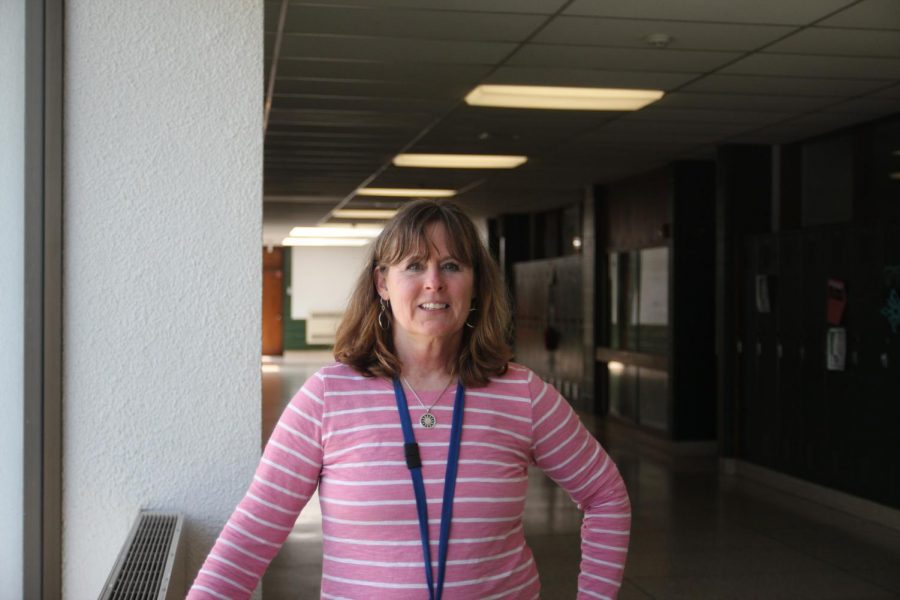West Math Teacher Retires After Teaching Over 3 Decades
She’s standing at the front board of her classroom at Wauwatosa West High School. She models a math problem on the board with her chalk while she hears the pencils scribbling behind her in their straight rows. The board reads September 1987. Much has changed since math teacher Cathy Razner first started teaching.
Razner will retire from West at the end of this school year after teaching math since she was 22 years old. She’s taught at West since 1987. Before West, she taught in White Bear Lake Minnesota and at Menominee.
“It was a very difficult decision deciding to retire because I love teaching. I’ve been doing this ever since I graduated and it’s kind of who I am,” Razner said.
When she first started teaching math classes it was mainly the teacher speaking. Regardless she always tried to incorporate fun activities. Now the math teacher is more of a facilitator. Teachers assist students to solve problems as a group with the new CPM curriculum.
“I think the new curriculum is better because it’s the way I had always envisioned math. Now students can see a reason why they’re learning it so they can eventually solve a certain problem,” Razner said.
When Razner started teaching at West in 1987 there were approximately 700 students. Now there are over 1,000. In 1987, there were 7 math teachers and there are currently 10. West has also become much more diverse. In the 2008-09 school year, 15.1% of students were economically disadvantaged and in 2013-14 30.3% of students were. But even with larger numbers and changes, the students haven’t really changed in her eyes.
“Students may come now with a little less structure maybe than they did before, but teaching is still teaching, and kids are still kids,” Razner said.
However, school safety was completely different. West was unlocked and open with multiple entrances and no supervision on the entrance. This was changed after the shooting of vice principal Dale Breitlow in 1993 at West. Afterward, the Wauwatosa school district and many other area schools changed their policies and made buildings safer by locking doors, and having only one main entrance. Schools also added school resource officers and practiced “lock-in” drills.
“It took about a year for the changes to be made but it was understandable because there was so much to change,” Razner said.
Approximately 10 years ago the use of Smart-Boards greatly changed many classrooms. Blackboards and overhead projectors were less needed after Smart-Boards created a more interactive learning experience able to do more.
“We use them all the time, mainly to project things and for kids to come up and write on it,” Razner said. “It can also help with lesson planning because you can make sure you include everything you wanted to talk about by just putting it up there.”
Wauwatosa West 2017 graduate Max Herteen remembers using the SmartBoard frequently in class. He’s currently a freshman at UW-Madison. He stated that the Smart Boards were “very helpful” during class.
Although, all technology in schools hasn’t been useful. The first cell phones were sold in the 1990’s but were very expensive. It wasn’t until the early 2000’s it became common for students to have flip phones. According to the PEW Research Center, approximately 45% of teenagers had cell phones in 2004 and 90% of teenagers had cell phones at the start of 2018.
Razner said, “It’s hard to keep students from having their phones out now and to manage it because they still have it in their pocket, or backpack and with them no matter what.”
Razner never shied against using technology in class. She was one of the first teachers in the district to drive the use of IPADS in the classroom.The district first began distributing Chromebooks to students in 2015. However they’ve also caused distractions and have not been as helpful as the IPADS Razner used before.
“With IPADS they didn’t need paper or pencils, and couldn’t lose their work unlike with the Chromebooks which are hard to do math with,” Razner said.
Although Razner adapted and integrated technology into the classroom, other changes were harder to bear. The Wisconsin legislature passed Act 10 in 2011. The act required teachers to pay more for health and retirement benefits, frequently cut teacher pay, and limited the power of teacher unions to collectively bargain with the district. Many teachers received lower salaries. Razner has been an active member of the Wauwatosa Education Association (WEA), a local union representing Wauwatosa teachers.
“Teachers felt like they weren’t respected as a whole, but I think Tosa as a community and the parents have always respected the teachers and been supportive to us,” Razner said.
Even after 30 years Razner still has the same personality as when she started at West. It was easily recognized by her prior students.
“I love Ms. Razner. She had a great energy and was always kind,” said Max Herteen.
Her teaching colleagues still agree.
“Mrs. Razner was full of energy when I first met her 12 years ago and she still is,” West math teacher Amy Fetherston said.
Razner and her coworkers also agree that they’re great friends in and out of school.
“The math department was always very close, and we still share strategies, lessons, and work together greatly. Mrs. Razner was even there at the hospital when my kids were born and I’ve known her children since they’ve been little,” West math teacher Angela Schoemann said.
Many things have changed around Razner but she has remained energetic and “enjoyed collaborating with colleges” throughout her time at West. She even has taught Jazzercise since she first started and now teaches four classes a week.
“Teaching math kept me doing math and jazzercise kept me moving and active, which are things important to me,” Razner said. “After I retire I’ll keep teaching Jazzercise.”
The Tosa Compass is the only dedicated Wauwatosa newspaper, providing quality news coverage. Your donation will support the student journalists of Wauwatosa East and West, helping us purchase equipment and cover our annual website hosting costs.













